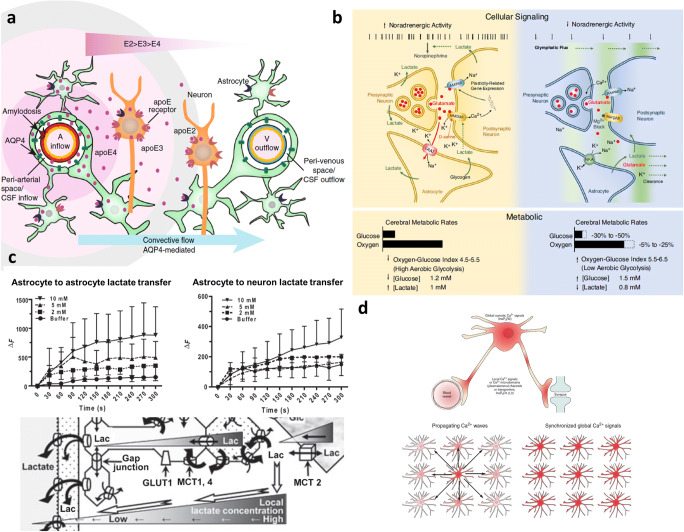Fig. 5.
Coupled ISF-CSF-lymphatic efflux and the objectives of this efflux. a Mice in which lenti-ApoE was delivered to their choroid plexus released ApoE to the CSF and ApoE contained in CSF was delivered to the periarteriolar space. ApoE in CSF convective flow revealed that the extent of convective/bulk flow into the ISF around the arterioles was isoform-dependent. ApoE2 diffused farther than ApoE3 which is also farther than ApoE4. This is evidence of the ISF influx from CSF. Reprinted with permission from Achariyar et al. [68]. b Wake-sleep cycle dictates cell signaling between neuron-neuron-astrocyte couples. While awake, extracellular K+ is increased under norepinephrine effect, and lactate is produced more and released with preferred aerobic glycolysis. During sleep, lactate, K+ as well as glutamate are cleared with glymphatic/lymphatic drainage while glucose consumption decreases more than oxygen consumption (less aerobic glycolysis). Reprinted with permission from DiNuzzo and Nedergaard [69]. c Astrocytes are coupled with astrocytes to make a reticular system. One of the impacts of this reticular system is that lactate transfer from astrocyte to astrocyte is greater and faster and that from astrocyte to the neuron is smaller. A larger volume of dilution and concentration gradient enables intracellular lactate to diffuse to paravascular fluid space. Extracellular lactate is also cleared to paravascular spaces due to the concentration gradient. Reprinted with permission from Gandhi et al. [70]. d Syncytium-forming astrocytes show propagating Ca+2 waves which are fast enough to explain long-range information transfer and even to make global synchronized global Ca+2 signals. Reprinted with permission from Verkhratsky and Nedergaard [71]

